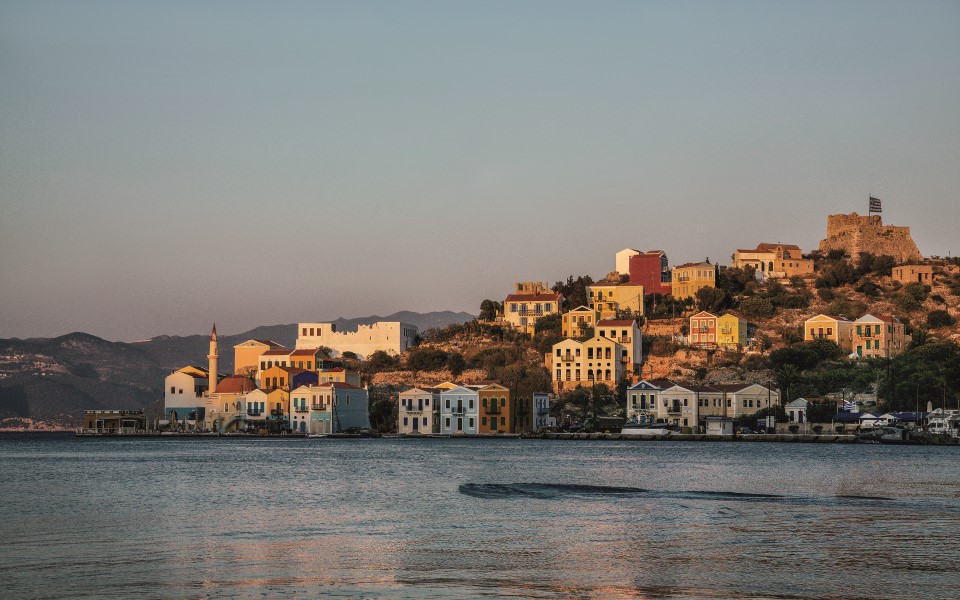Kordoni
The port’s U-shaped quay consists of a narrow strip, also known as “to kordoni”, or “the shoelace,” that runs along the entire waterfront of the village, and it’s where most of its activity is concentrated. Shopping, entertainment, leisure – almost every aspect of life plays out at the water’s edge. It takes no time at all to locate all the important spots and to become familiar with the lie of the land.
For most visitors, getting to know the island starts at the pier where the ferryboat docks. Watch how the captain manages to maneuver a 150-meter ship in the 200-meter harbor mouth – it’s quite impressive. There’s almost always some ship docked here, be it a passenger ferry or a navy frigate. It’s not always pleasant as the sound of roaring engines upsets the calm of the waterfront.
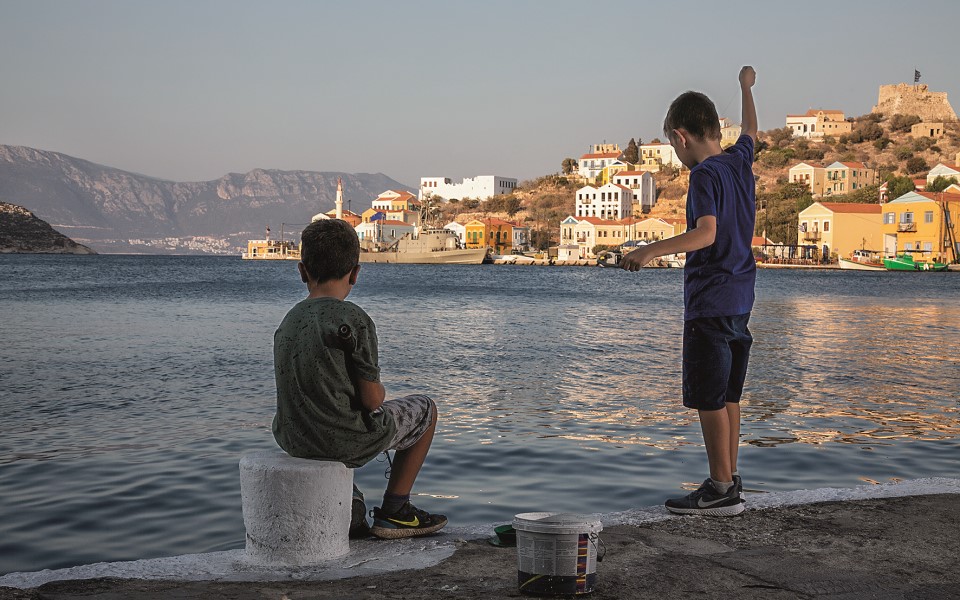
© Nikos Pilos
The open area in the middle of the harbor, known as Mesi tou Yialou, used to be the epicenter of the community’s social life. Today it is the site of a memorial dedicated to the victims of war, and it’s still where various public events are held. Most of the rest of the harbor is ringed by a densely packed row of beautiful neoclassical houses whose ground floors are given over to tavernas, cafés and a few souvenir shops. Take a moment to examine the Mercato building, the former fish-and-meat market and an architectural jewel from the Italian occupation. Right beside it, Stratos Café is a strategic stop for coffee lovers – by this point in your travels, you’ll probably have noted the importance of coffee, either iced or hot, to the Greeks!
As you walk along the waterfront, don’t forget to look down into the water now and then; there’s a good chance you’ll spot a sea turtle. In 2009, when a new marina was built in Kaş on the Turkish coast, dozens of these wonderful creatures were displaced, and they now seek shelter in Kastellorizo’s welcoming harbor. They also come for any spare food from the seaside tavernas, although the practice of throwing them tidbits is not encouraged, not least because they become territorial about feeding grounds and may nip at people swimming in the area.
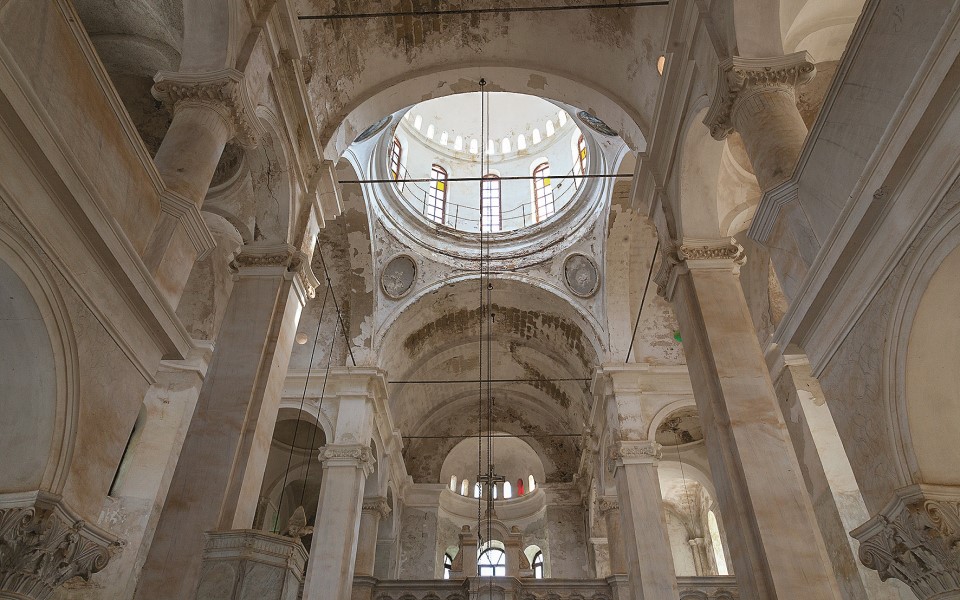
© Nikos Pilos
Another open area on the port leads to a cluster of businesses offering most of the services a traveler might need: there’s a taxi stand for the island’s lone taxi (Tel. (+30) 693.873.9178), the Papoutsis travel office (Tel. (+30) 22460.706.30), a single rental shop with just two motorcycles, a bakery, two supermarkets and public toilets.
As the waterfront curves, the row of houses gives way to a second opening and the Church of Aghios Georgios Pigadiou, or Saint George of the Well. There are another six churches on the island dedicated to Saint George. It’s a good idea to familiarize yourself with them, as it will help you find your way around. They are Saint George of the Island (Aghios Georgios tou Nisiou), of the Mountain (tou Vounou) and of the Field (tou Horafiou), as well as Aghios Georgios Ftochoulaki (the Poor) and Aghios Georgios tis Ro (of Ro). Back at Aghios Georgios Pigadiou, you’ll also find Remezzo, the island’s best café-bar for local sweets, a glass of beer or other refreshments.
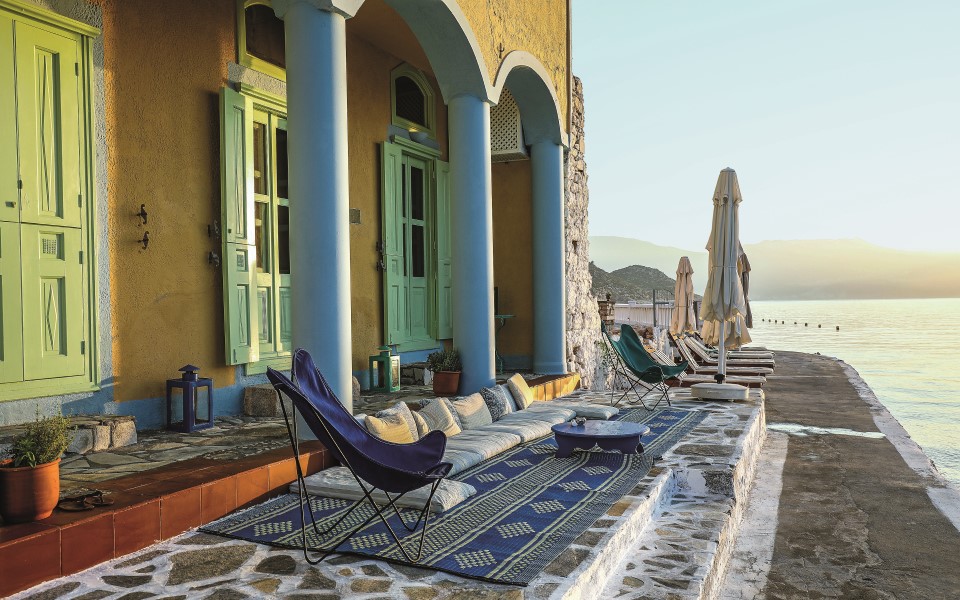
© Nikos Kokkalias
All of the tiny streets that lead off from the harbor are worth exploring, as they take you into pretty neighborhoods like the charming Aghios Merkourios area, with its abandoned buildings (including the former ice factory), beautifully restored mansions and flower-filled courtyards. Daily life takes place here in the narrow alleys that end in shared outdoor spaces and behind the windows through which you can’t help but peek. With the residences so close together, there’s a communal feeling that may help to explain the reputation of the islanders as inveterate gossips.
Back at the Kordoni, you’ll find Pera Meria, a quieter part of the main town, where the buildings, not as closely packed, are better able to show off their architectural attributes and pleasing colors. The famous Blue House, featured in the film “Mediterraneo,” is near the end of the quay, along with the iconic hotel Mediterraneo and the Hotel Megisti, at both of which you can dive into the sea just meters away from your bed.
Just past the Hotel Megisti at one end of the harbor is a small building that looks like a church but isn’t. Known as the Gazadika, it was once a warehouse for fuel but is now the studio of sculptor Alexandros Zigouris.
Kavos
As evidenced by the castle that dominates it, unmissable with its Greek flag waving prominently above it, the Kavos headland has always been a strategic observation point. Located between two of the island’s three natural harbors, and with a clear view of the Megisti island group and the eastern sea corridor, it was home to wealthy shipowners and captains.
Before the German bombings in 1943 and the big fire of 1944, Kavos was covered with stately three-story houses. Today, as you wander among the restored villas, you’ll also walk past ruined structures that nonetheless give you an idea of the layouts of these lost houses.
Hungry yet?
As you’ll see by the boats in the harbor, only a handful of the islanders still fish professionally, but there are enough of them to ensure that the tavernas are well-stocked with fresh seafood. All the tavernas are family-run businesses and each has its own character. You’ll find that things here are a bit more expensive than you might expect, so ask to see the menu before you decide where to eat.
At the seafood taverna BILLY’S, we enjoyed small shrimp and the grilled sargo, or white seabream. Agora (Tel. (+30) 22460.491.38) is an honest little eatery known for its souvlaki; it also serves takeaway.
At Lazarakis (Tel. (+30) 693.236.0273), located right on the harbor, the dishes are more upmarket and include very good octopus, tuna carpaccio and seafood pasta.
At Alexandra, you’ll find good food, good service and a great atmosphere, and some spontaneous merrymaking may very well break out during your meal.
Mikro Parisi, or Little Paris (Tel. (+30) 697.670.4588) is on the quieter side of the harbor. We enjoyed the grilled flathead grey mullet and the fish soup; while the service was slow, owner Irini and her brother Michalis were so delightful we came back a second time.
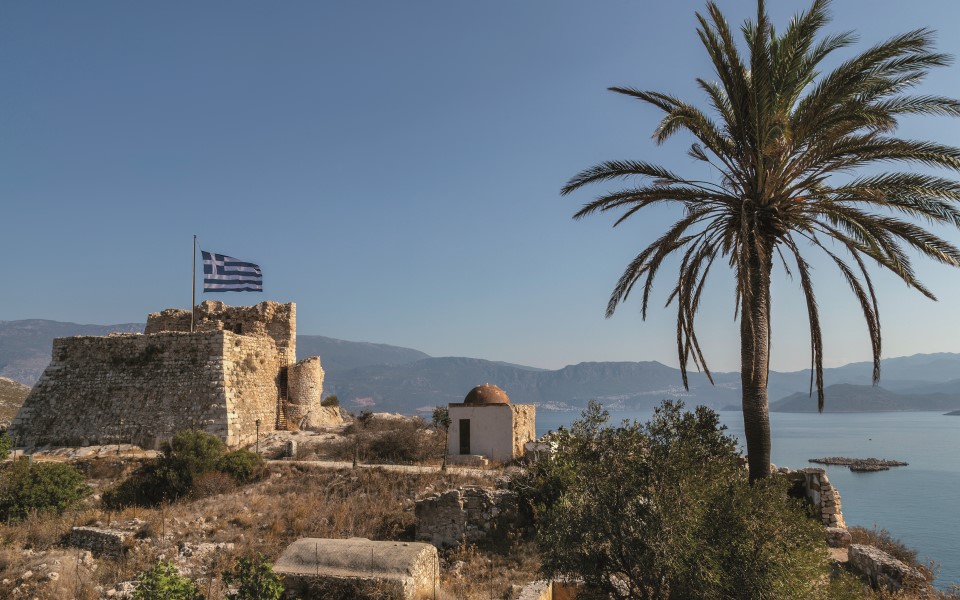
© Nikos Pilos
In this small area, there’s much to learn of the island’s history, starting with the Castle of the Knights of Saint John, whose sobriquet of Castello Rosso gave the island its name. This castle features in the descriptions given by nearly all travelers who wrote of Kastellorizo. Built in the 14th century with materials from an ancient acropolis, today it consists only of a fortified courtyard and ruins of its interior space.
Nonetheless, the spot affords splendid panoramic views of Aghios Stefanos in the north, Cape Nifti in the west, and Paliokastro and Avlonia inland. You can also see many of the small islands that make up the group: Psoradia, Kalikatzaraki and its twin Aghios Georgios, Polyfados, Psomi, Koutsoumbas, Mavropini and Mavropinaki (the last three mark the border with Turkey).
Take the road past the old windmill – slated for restoration – and the churches of Aghios Nikolaos and Aghios Dimitrios to reach the Kastellorizo Archaeological Museum, housed in one of the castle’s forts. It contains finds from the island dating back to antiquity, as well as Byzantine relics, artifacts recovered from the sea, testimonials from foreign travelers, murals from the Church of Saint George of the Castle and an entire hall dedicated to the island’s folk art and culture. The ground floor focuses on maritime history.
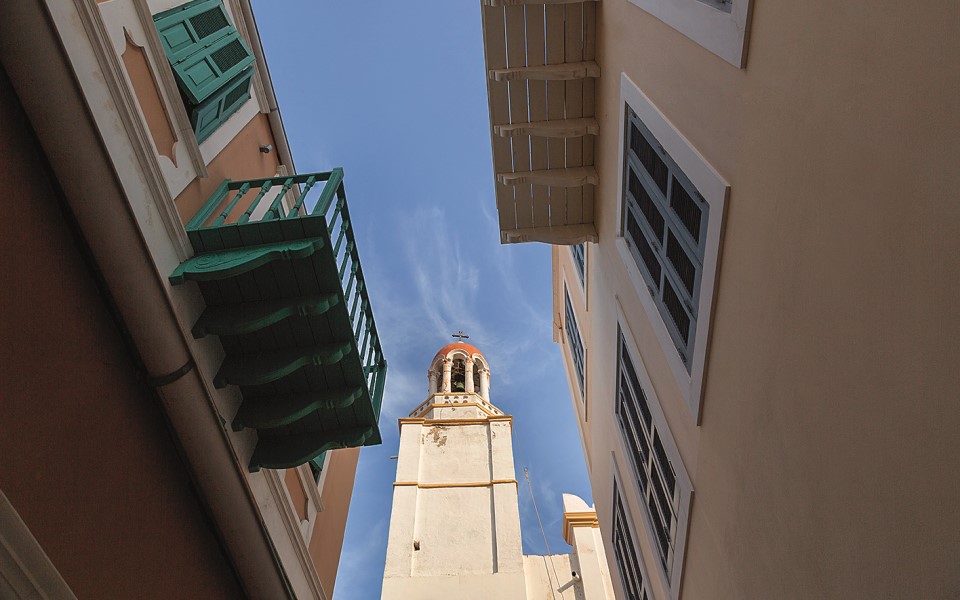
© Nikos Pilos
Back in the late 18th century, the area around the castle was inhabited by a small Muslim community and you can still see examples of Ottoman architecture in the restored hamam baths, in the ruins of the school, and in the mosque, which is on the lane leading down to the port, sandwiched between Italian-era administrative buildings.
Today the mosque is home to the Kastellorizo Historical Collection, which provides valuable insights into life during the island’s more prosperous past. The collection of documents, photographs and memorabilia is beautifully arranged into a narrative stretching from the 19th century until the island’s integration into the Greek state in 1948. Do not miss the screening of the excellent video “Kastellorizo Then and Now” (in Greek with English subtitles).
If you take the path around the outer perimeter of Kavos, you’ll come across the 4th-century BC Lycian Tomb, which points to the close ties that have existed between the island and its Anatolian neighbors since ancient times. The view to the Turkish coast and Kaş (known in Greek as Antiphellos) from that path, which leads to the small harbor of Mandraki, is quite lovely.
Info
Kastellorizo Archaeological Museum (Tel. (+30) 22460.492.83) and the Historical Collection (Tel. (+30) 22460. 706.20) are open daily except Tuesdays 09:00-16:00. The 21-minute “Kastellorizo Then and Now” video is screened at 12:00 and again at 14:00.
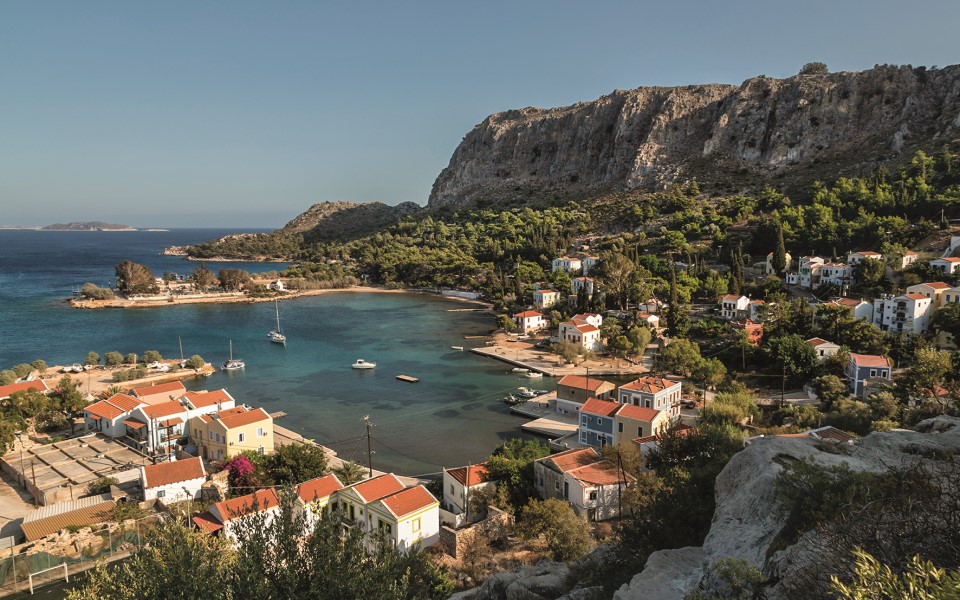
© Nikos Pilos
Mandraki
The island’s second port used to be abuzz with the business of boat-building, as you can see from the slipways in the shallows used for pulling boats and hydroplanes out of the water, and from the remains of an old steam mill. Now it’s the quietest part of Kastellorizo, with just one small shipyard that only operates for boat repairs.
Mandraki has a small church dedicated to Saint Paraskevi, and a large cemetery, named after Saint Savvas, that contains the graves of locals as well as of French soldiers from WWI. The island’s only gas station is at the end of the road here, though this information is irrelevant for most visitors, as motorized transport is rarely needed here.
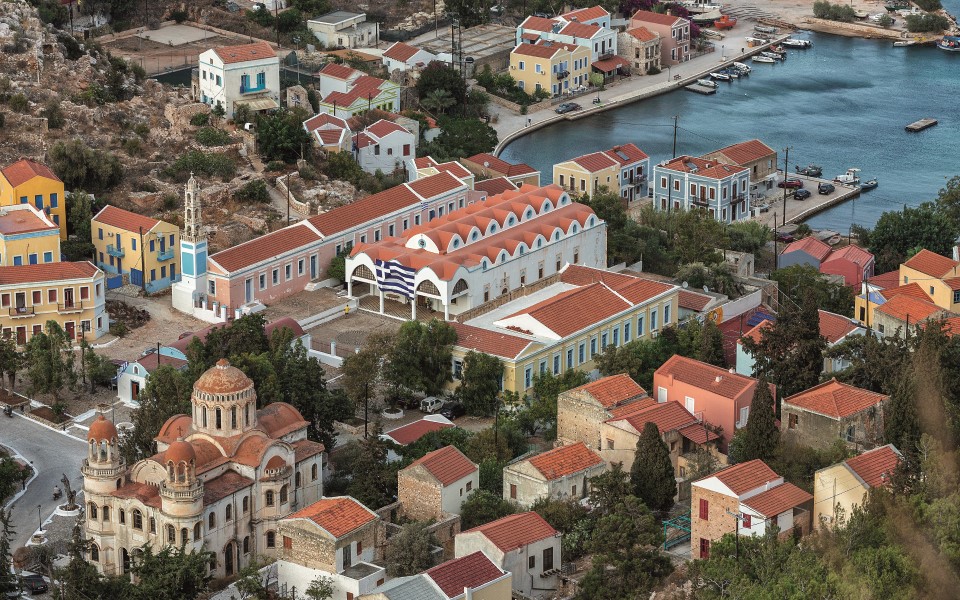
© Nikos Pilos
Horafia
Horafia, which means “fields” in Greek, is the area where the residents of Kastellorizo once had their family farms. Today, it is the island’s religious and educational center, home to the Cathedral of Saints Constantine and Helena on one side of a pretty pebbled courtyard and, opposite it, the Santrape Town School and the Girl’s School (Parthenagogio).
The Town School was endowed by Loukas Santrape (1852-1911), a wealthy contractor who had worked on irrigation systems in Egypt. He was also the benefactor of the Church of Aghios Georgios in Horafia, an impressive eclectic-style edifice that was never completed but is soon to be restored.
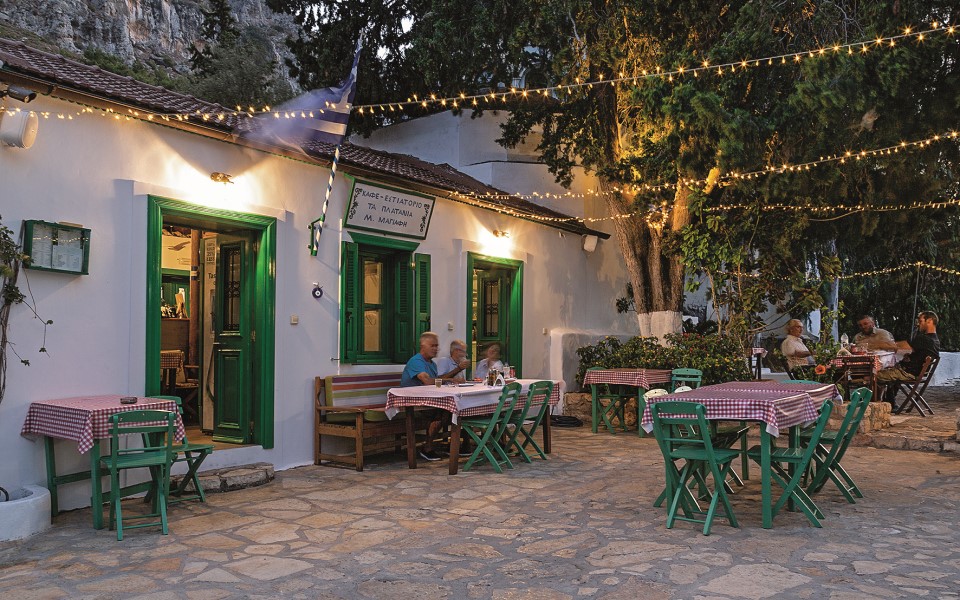
© Nikos Pilos
There are two more houses of worship in the immediate area – the church of Panaghia Horafiou and that of Aghios Spyridonas, and an impressive bust of the Lady of Ro, a woman who raised the Greek flag over the islet of Ro every day for decades, affirming Greek sovereignty with her action.
Among the other buildings in Horafia is the traditional taverna Platania (Tel. (+30) 22460.492.06). Now in operation for 35 years, and one of the locations used in the film “Mediterraneo,” the taverna is presently run by two sisters and a daughter. These tireless women prepare an array of delicious home-style dishes every day, cooking up dolmadakia (stuffed vine leaves), pots of goat meat, chickpea fritters and octopus in tomato sauce.
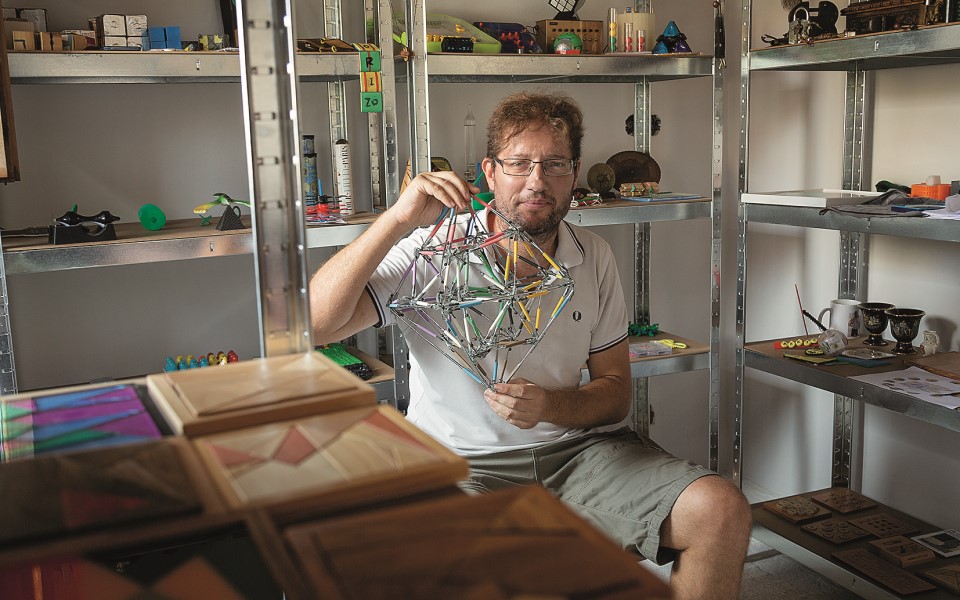
© Nikos Pilos
Museum of Puzzles
The rainbow-painted path behind the Church of Aghios Georgios tou Horafiou will lead you to Greece’s only Museum of Puzzles. The brainchild of mathematician and puzzle-maker Pantazis Houlis, it presents young and old with clever cerebral teasers. Born in the Australian city of Perth but raised on Kastellorizo, Houlis realized his dream in 2012 when he opened a museum dedicated to puzzles. He is an avid puzzle collector and has amassed one of the largest collections in the world, with over 4,000 items, a number of which he designed himself. Apart from being an active member of the International Puzzle Party, he is also an excellent tour guide with an in-depth knowledge of Kastellorizo’s paths and trails (see below: Hiking Trails).
Info
Museum of Puzzles: Open Mon., Tue. & Thu. 16:00-18:00, kastellorizo.net, Tel. (+30) 698.086.5814
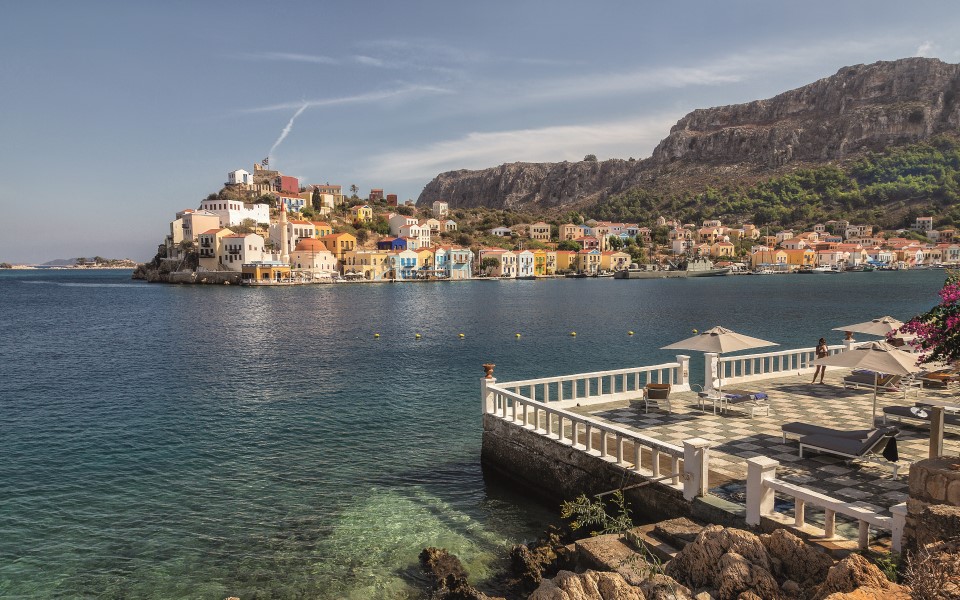
© Nikos Pilos
THE COUNTRYSIDE
Even though the island’s cosmopolitan harbor town tends to steal the show, the rocky countryside – rarely explored by visitors or even archaeologists – is in itself reason enough to make the trip to Kastellorizo. The sheer cliffs and craggy passes, reminiscent of the foothills of a large mountain range, mean that you’ll need to expend some effort while exploring, but you’ll be rewarded with the sight of native flora and fauna (including delightful little tortoises) and ruins from different historical periods.
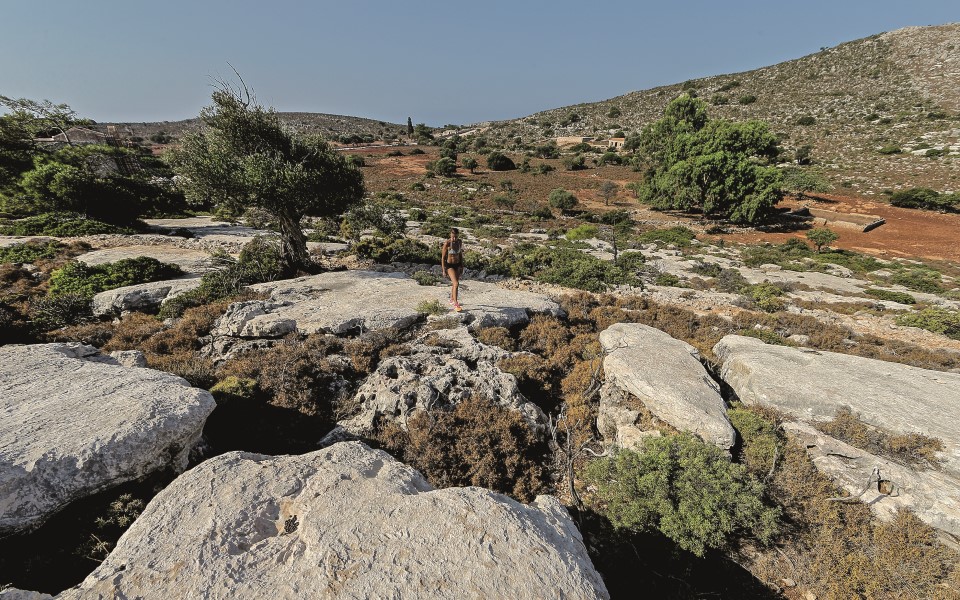
© Paolo Zanoni
Aghios Georgios tou Vounou (Saint George of the Mountain)
An ascent of some 400 steps starting at the top of the town takes you up the mountainside to the monastery, giving you a taste of the island’s wild landscape and glimpses at the remains of ancient grape stomping pits, funerary monuments and fortifications. The recently restored monastery is surrounded by a high wall, which encompasses the katholikon, cells and auxiliary spaces built around a courtyard with a pebbled floor.
The basement crypt inside the church is quite interesting and is dedicated to Saint Charalambos. If you want to look inside, you’ll need to arrange your visit with the island’s taxi driver, as he has the keys to the monastery (Tel. (+30) 693.873.9178).
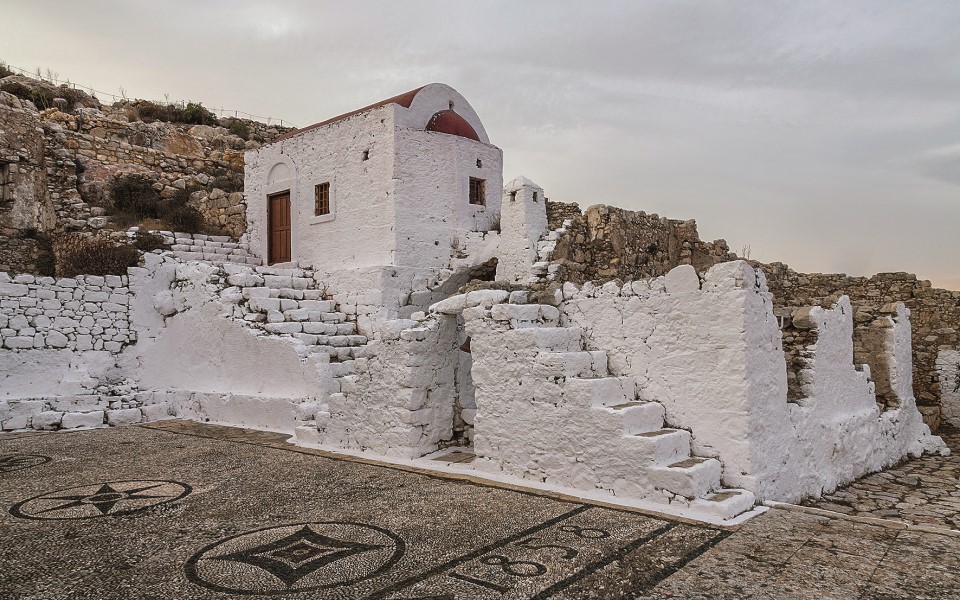
© Nikos Pilos
Paliokastro
The best time to visit the site of the ancient acropolis is in the late afternoon, just before the sun sets behind the small island of Ro. From here, the views out to sea and back over the village are amazing.
Paliokastro served as the center of the island’s ancient fortification system, and was in use until the Middle Ages. It served as an excellent vantage point to observe activity in the harbor and along the seaways, and it was also a part of an information system (known as phryctoria, it used fires that transmitted signals between towers) that reached as far as the islets of Strongyli and Ro, and the coast of Asia Minor. The acropolis was surrounded by walls and had large water tanks cut into big rocks. The fortified towers, the cisterns and the Italian cannon embrasures testify to the island’s turbulent past and its strategic importance, the latter a fact unchanged through history.
Info
There are no more than 10 kilometers’ worth of paved roads on the island and you’ll see more people traveling them by foot than by car. The further away you get from the main settlement, the more obvious the military presence becomes, so keep an eye out when you’re out walking and hiking (and when you’re about to take pictures) for military facilities such as guard posts and roads that are off-limits.
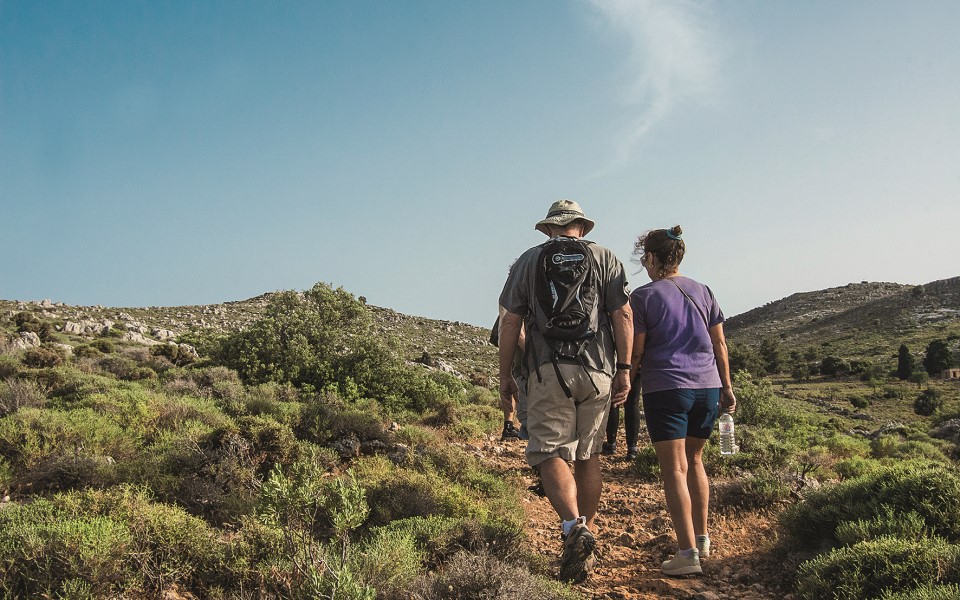
© Visit Kastellorizo
The hiking trails
The island recently acquired signposting for two short hiking trail networks: one around Aghios Georgios tou Vounou and Avlonia in the south and the other around the cape of Aghios Stefanos to the north.
However, there are many more trails known to the locals, including Pantazis Houlis (see The Puzzle Museum), who is always ready to help with tips and directions or even to accompany hikers. Houlis took us on a two-hour walk with impressive variations in the landscape and terrain.
We saw stone structures and sections affording views of the sea below. The trail starts at the airport, goes through a field owned by the Myriklis family – containing the ruins of an old house and a large carob tree – and along ancient paths meandering among walls and deep cisterns. The path above the Blue Grotto was a highlight, thanks to the marvelous view out to Strongyli. The trail back starts here and runs across a red dirt plateau before joining the main road as it heads towards the area known as Kiolia.
Guided tours
Eleni Karavelatzi is not a professional guide, but she is a young person who loves the island and enjoys sharing its secrets with visitors. On her website, visitkastellorizo.com, you can find all sorts of information and tips for interesting walks and sea tours, or you can contact her (Tel. (+30) 697.709.2616) and ask for a tailor-made package that includes excursions to less popular destinations, including the islet of Ro.

